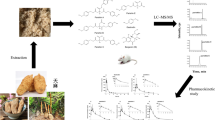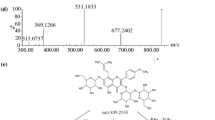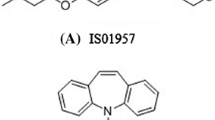Abstract
The food-related isothiocyanate sulforaphane (SFN), a hydrolysis product of the secondary plant metabolite glucoraphanin, has been revealed to have cancer-preventive activity in experimental animals. However, these studies have often provided inconsistent results with regard to bioavailability, bioaccessibility, and outcome. This might be because the endogenous biotransformation of SFN metabolites to the structurally related erucin (ERN) metabolites has often not been taken into account. In this work, a fully validated liquid chromatography tandem mass spectrometry (LC–MS–MS) method was developed for the simultaneous determination of SFN and ERN metabolites in a variety of biological matrices. To reveal the importance of the biotransformation pathway, matrices including plasma, urine, liver, and kidney samples from mice and cell lysates derived from colon-cancer cell lines were included in this study. The LC–MS–MS method provides limits of detection from 1 nmol L−1 to 25 nmol L−1 and a mean recovery of 99 %. The intra and interday imprecision values are in the range 1–10 % and 2–13 %, respectively. Using LC–MS–MS, SFN and ERN metabolites were quantified in different matrices. The assay was successfully used to determine the biotransformation in all biological samples mentioned above. For a comprehensive analysis and evaluation of the potential health effects of SFN, it is necessary to consider all metabolites, including those formed by biotransformation of SFN to ERN and vice versa. Therefore, a sensitive and robust LC–MS–MS method was validated for the simultaneous quantification of mercapturic-acid-pathway metabolites of SFN and ERN.

Biotransformation of sulforaphane and erucin metabolites in mice and cell culture



Similar content being viewed by others
Abbreviations
- ACN:
-
Acetonitrile
- DMEM:
-
Dulbecco’s modified Eagle’s medium
- DMSO:
-
Dimethyl sulfoxide
- ERN:
-
Erucin
- ERN–Cys:
-
ERN–cysteine
- ERN–GSH:
-
ERN–glutathione
- ERN–NAC:
-
ERN–N-acetylcysteine
- ESI:
-
Electrospray ionization
- FA:
-
Formic acid
- GSH:
-
Glutathione
- HPLC:
-
High-performance liquid chromatography
- LC–MS–MS:
-
Liquid chromatography–tandem mass spectrometry
- LOQ:
-
Limit of quantification
- MeOH:
-
Methanol
- NMR:
-
Nuclear magnetic resonance
- R 2 :
-
Coefficient of determination
- SFN:
-
Sulforaphane
- SFN–Cys:
-
SFN–cysteine
- SFN–CysGly:
-
SFN–cysteinylglycine
- SFN–NAC:
-
SFN–N-acetylcysteine
- SPE:
-
Solid-phase extraction
- TFA:
-
Trifluoroacetic acid
References
Higdon JV, Delage B, Williams DJ, Dashwood RH (2007) Cruciferous vegetables and human cancer risk: epidemiologic evidence and mechanistic basis. Pharm Res 55:224–236
Traka M, Mithen R (2009) Glucosinolates, isothiocyanates and human health. Phytochem Rev 8:269–282
Juge N, Mithen RF, Traka M (2007) Molecular basis for chemoprevention by sulforaphane: a comprehensive review. Cell Mol Life Sci 64:1105–1127
Sestili P, Paolillo M, Lenzi M, Colombo E, Vallorani L, Casadei L, Martinelli C, Fimognari C (2010) Sulforaphane induces DNA single strand breaks in cultured human cells. Mutat Res 689:65–73
Sekine-Suzuki E, Yu D, Kubota N, Okayasu R, Anzai K (2008) Sulforaphane induces DNA double strand breaks predominantly repaired by homologous recombination pathway in human cancer cells. Biochem Biophys Res Commun 377:341–345
Piberger AL, Köberle B, Hartwig A (2014) The broccoli-born isothiocyanate sulforaphane impairs nucleotide excision repair: XPA as one potential target. Arch Toxicol 88:647–658
Sarikamis G, Marquez J, Maccormack R, Bennett RN, Roberts J, Mithen R (2006) High glucosinolate broccoli: a delivery system for sulforaphane. Mol Breeding 8:219–228
Hanschen FS, Rohn S, Mewis I, Schreiner M, Kroh LW (2012) Influence of the chemical structure on the thermal degradation of the glucosinolates in broccoli sprouts. Food Chem 130:1–8
Clarke JD, Dashwood RH, Ho E (2008) Multi-targeted prevention of cancer by sulforaphane. Cancer Lett 269:291–304
Krul C, Humblot C, Philippe C, Vermeulen M, van Nuenen M, Havenaar R, Rabot S (2002) Metabolism of sinigrin (2-propenyl glucosinolate) by the human colonic microflora in a dynamic in vitro large-intestinal model. Carcinogenesis 23:1009–1016
Luang-In V, Narbad A, Nueno-Palop C, Mithen R, Bennett M, Rossiter JT (2014) The metabolism of methylsulfinylalkyl- and methylthioalkyl-glucosinolates by a selection of human gut bacteria. Mol Nutr Food Res 58:875–883
Al-Janobi AA, Mithen RF, Gasper AV, Shaw PN, Middleton RJ, Ortori CA, Barrett DA (2006) Quantitative measurement of sulforaphane, iberin and their mercapturic acid pathway metabolites in human plasma and urine using liquid chromatography-tandem electrospray ionisation mass spectrometry. J Chromatogr B Anal Technol Biomed Life Sci 844:223–234
Kumar A, Sabbioni G (2010) New biomarkers for monitoring the levels of isothiocyanates in humans. Chem Res Toxicol 23:756–765
Kassahun K, Davis M, Hu P, Martin B, Baillie T (1997) Biotransformation of the naturally occurring isothiocyanate sulforaphane in the rat: identification of phase I metabolites and glutathione conjugates. Chem Res Toxicol 10:1228–1233
Clarke JD, Hsu A, Riedl K, Bella D, Schwartz SJ, Stevens JF, Ho E (2011) Bioavailability and inter-conversion of sulforaphane and erucin in human subjects consuming broccoli sprouts or broccoli supplement in a cross-over study design. Pharmacol Res 64:456–463
Saha S, Hollands W, Teucher B, Needs PW, Narbad A, Ortori CA, Barrett DA, Rossiter JT, Mithen RF, Kroon PA (2012) Isothiocyanate concentrations and interconversion of sulforaphane to erucin in human subjects after consumption of commercial frozen broccoli compared to fresh broccoli. Mol Nutr Food Res 56:1906–1916
Verkerk R, Schreiner M, Krumbein A, Ciska E, Holst B, Rowlan I, De Schrijver R, Hansen M, Gerhauser C, Mithen R, Dekker M (2009) Glucosinolates in Brassica vegetables: the influence of the food supply chain on intake, bioavailability and human health. Mol Nutr Food Res 53:219–265
Papi A, Orlandi M, Bartolini G, Barillari J, Iori R, Paolini M, Ferroni F, Fumo MG, Pedulli GF, Valgimigli L (2008) Cytotoxic and antioxidant activity of 4-methylthio-3-butenyl isothiocyanate from Raphanus sativus L. (Kaiware daikon) sprouts. J Agric Food Chem 56:875–883
Lamy E, Hertrampf A, Herz C, Schuler J, Erlacher M, Bertele D, Bakare A, Wagner M, Weiland T, Lauer U, Drognitz O, Huber R, Rohn S, Giesemann T, Mersch-Sundermann V (2013) Preclinical evaluation of 4-methylthiobutyl isothiocyanate on liver cancer and cancer stem cells with different p53 status. PLoS One. doi:10.1371/journal.pone.0070846
Ganin H, Rayo J, Amara N, Levy N, Krief P, Meijler MM (2013) Sulforaphane and erucin, natural isothiocyanates from broccoli, inhibit bacterial quorum sensing. Med Chem Commun 4:175–179
Zhang Y, Wade KL, Prestera T, Talalay P (1996) Quantitative determination of isothiocyanates, dithiocarbamates, carbon disulfide, and related thiocarbonyl compounds by cyclocondensation with 1,2-benzenedithiol. Anal Biochem 239:160–167
Shapiro TA, Fahey JW, Wade KL, Stephenson KK, Talalay P (2001) Chemoprotective glucosinolates and isothiocyanates of broccoli sprouts: metabolism and excretion in humans. Cancer Epidemiol Biomarkers Prev 10:501–508
Ye L, Dinkova-Kostova AT, Wade KL, Zhang Y, Shapiro TA, Talalay P (2002) Quantitative determination of dithiocarbamates in human plasma, serum, erythrocytes and urine: pharmacokinetics of broccoli sprout isothiocyanates in humans. Clin Chim Acta 316:43–353
Cramer JM, Jeffery EH (2011) Sulforaphane absorption and excretion following ingestion of a semi-purified broccoli powder rich in glucoraphanin and broccoli sprouts in healthy men. Nutr Cancer 63:196–201
Budnowski J, Hanschen FS, Lehmann C, Haack M, Brigelius-Flohe R, Kroh LW, Blaut M, Rohn S, Hanske L (2013) A derivatization method for the simultaneous detection of glucosinolates and isothiocyanates in biological samples. Anal Biochem 441:199–207
Vermeulen M, van Rooijen HJ, Vaes WH (2003) Analysis of isothiocyanate mercapturic acids in urine: a biomarker for cruciferous vegetable intake. J Agric Food Chem 51:3554–3559
Gasper AV, Al-Janobi A, Smith JA, Bacon JR, Fortun P, Atherton C, Taylor MA, Hawkey CJ, Barrett DA, Mithen RF (2005) Glutathione S-transferase M1 polymorphism and metabolism of sulforaphane from standard and high-glucosinolate broccoli. Am J Clin Nutr 82:1283–1291
Agrawal S, Winnik B, Buckley B, Mi L, Chung FL, Cook TJ (2006) Simultaneous determination of sulforaphane and its major metabolites from biological matrices with liquid chromatography-tandem mass spectroscopy. J Chromatogr B Anal Technol Biomed Life Sci 840:99–107
Egner PA, Kensler TW, Chen JG, Gange SJ, Groopman JD, Friesen MD (2008) Quantification of sulforaphane mercapturic acid pathway conjugates in human urine by high-performance liquid chromatography and isotope-dilution tandem mass spectrometry. Chem Res Toxicol 21:1991–1996
Kensler TW, Chen JG, Egner PA, Fahey JW, Jacobson LP, Stephenson KK, Ye L, Coady JL, Wang JB, Wu Y, Sun Y, Zhang QN, Zhang BC, Zhu YR, Qian GS, Carmella SG, Hecht SS, Benning L, Gange SJ, Groopman JD, Talalay P (2005) Effects of glucosinolate-rich broccoli sprouts on urinary levels of aflatoxin-DNA adducts and phenanthrene tetraols in a randomized clinical trial in He Zuo township, Qidong, People's Republic of China. Cancer Epidemiol Biomarkers Prev 14:2605–2613
Hauder J, Winkler S, Bub A, Rufer CE, Pignitter M, Somoza V (2001) LC-MS/MS quantification of sulforaphane and indole-3-carbinol metabolites in human plasma and urine after dietary intake of selenium-fortified broccoli. J Agric Food Chem 59:8047–8057
Li Y, Zhang T, Li X, Zou P, Schwartz SJ, Sun D (2013) Kinetics of sulforaphane in mice after consumption of sulforaphane-enriched broccoli sprout preparation. Mol Nutr Food Res 57:2128–2136
Vermeulen M, Zwanenburg B, Chittenden GJ, Verhagen H (2003) Synthesis of isothiocyanate-derived mercapturic acids. Eur J Med Chem 38:729–737
Guidance for Industry: Bioanalytical Method Validation. U.S. Department of Health and Human Service, Food and Drug Administration, Center for Drug Evaluation and Research (CDER), Center for Vetenery Medicine (CVM), May 2001, BP. Available on the internet at http://www.fda.gov/downloads/Drugs/Guidances/ucm070107.pdf
Herz C, Hertrampf A, Zimmermann S, Stetter N, Wagner M, Kleinhans C, Erlacher M, Schüler J, Platz S, Rohn S, Mersch-Sundermann V, Lamy E (2014) The isothiocyanate erucin abrogates telomerase in hepatocellular carcinoma cells in vitro and in an orthotopic xenograft tumour model of HCC. J Cell Mol Med. doi:10.1111/jcmm.12412
Bunz F, Dutriaux A, Lengauer C, Waldman T, Zhou S, Brown JP, Sedivy JM, Kinzler KW, Vogelstein B (1998) Requirement for p53 and p21 to sustain G(2) arrest after DNA damage. Science 282:1497–1501
Platz S, Kühn C, Schiess S, Schreiner M, Mewis I, Kemper M, Pfeiffer A, Rohn S (2013) Determination of benzyl isothiocyanate metabolites in human plasma and urine by LC-ESI-MS/MS after ingestion of nasturtium (Tropaeolum majus L.). Anal Bioanal Chem 405:7427–7736
Author information
Authors and Affiliations
Corresponding author
Electronic supplementary material
Below is the link to the electronic supplementary material.
ESM 1
(PDF 21 kb)
Rights and permissions
About this article
Cite this article
Platz, S., Piberger, A.L., Budnowski, J. et al. Bioavailability and biotransformation of sulforaphane and erucin metabolites in different biological matrices determined by LC–MS–MS. Anal Bioanal Chem 407, 1819–1829 (2015). https://doi.org/10.1007/s00216-015-8482-z
Received:
Revised:
Accepted:
Published:
Issue Date:
DOI: https://doi.org/10.1007/s00216-015-8482-z




